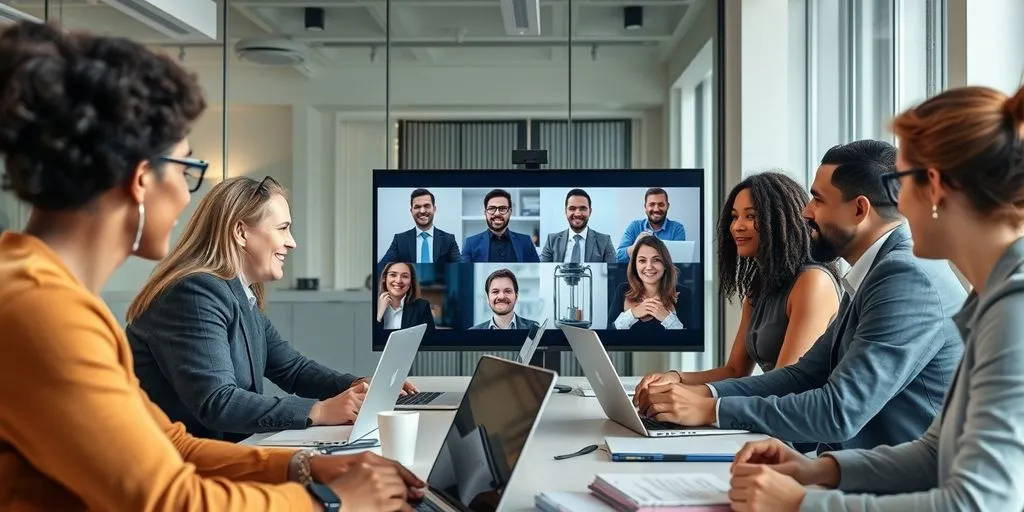Optimizing Meetings: Creating Effective Agendas for Video Conferencing
September 16, 2024
.webp)
Meetings are a big part of our work life, especially with video conferencing becoming more common. But not all meetings are useful. To make meetings better, we need good agendas. A good agenda helps keep the meeting on track and makes sure everyone knows what to expect. This article will show you how to create effective agendas for your video conferences.
Key Takeaways on Optimizing Video Meetings
- Importance of Agendas: A well-structured agenda is crucial for keeping meetings focused and ensuring that all key topics are covered. It helps streamline discussions and avoids wasting time on off-topic conversations.
- Boosting Productivity: Well-organized meetings enhance team productivity and morale by aligning everyone on goals and facilitating better decision-making and problem-solving.
- Avoiding Pitfalls: Poorly planned meetings can lead to wasted time and frustration, as discussions may drift and important issues may be missed. A clear agenda helps prevent these problems.
- Collaborative Approach: Involving team members in creating the agenda ensures all relevant topics are included and fosters a sense of ownership, leading to more engaging and effective meetings.
- Role Assignment: Designating specific roles such as facilitators and note-takers helps meetings run smoothly and ensures that key points and action items are documented and followed up on.
- Time Management: Setting time limits for agenda items and using strategies to stay on schedule helps keep meetings efficient and focused. If necessary, manage overruns by summarizing key points and scheduling follow-ups.
- Pre-Meeting Preparation: Distributing the agenda and preparing necessary materials in advance allows participants to come prepared, leading to more productive and streamlined discussions.
Register Your LLC
Company Registration
START NOWThe Importance of Optimizing Meetings
Benefits of Well-Structured Meetings
Well-structured meetings can significantly boost team productivity and morale. They ensure that everyone is on the same page, leading to better decision-making and creative problem-solving. When meetings are organized, they can foster collaboration and help in achieving business goals more efficiently.
Common Pitfalls of Poorly Planned Meetings
Poorly planned meetings often lead to wasted time and frustration. Without a clear agenda, discussions can go off track, and important topics might be overlooked. This can result in unproductive and inefficient gatherings, which can demotivate team members and hinder progress.
Impact on Team Productivity
Optimizing meetings is crucial for maintaining high levels of productivity. When meetings are well-planned, they complement periods of deep work, allowing team members to focus on their tasks without unnecessary interruptions. This balance is essential for fostering innovative thinking and achieving effective business outcomes.
In any organization, meetings are a fundamental component of communication and decision-making. However, the challenge often lies in optimizing these meetings for maximum efficiency, ensuring they contribute effectively to business objectives without impeding productivity.
Collaborative Agenda Building
Involving Team Members
When you create an agenda, involve your team members. This way, everyone has a say in what will be discussed. It makes the meeting more relevant and ensures that all important topics are covered. By including everyone, you foster a sense of ownership and commitment.
Using Collaborative Tools
Use collaborative tools to build your agenda. These tools make it easy for everyone to contribute. They also help keep everything organized. Some great workshop tools can help you at each step of the design and delivery process. This approach ensures that the agenda is comprehensive and addresses the team's needs.
Benefits of Diverse Perspectives
When you involve different people in creating the agenda, you get diverse perspectives. This can lead to more creative solutions and better decision-making. It also makes everyone feel valued and heard, which can boost team morale.
A collaborative agenda is not just a list of topics; it's a tool for making meetings more effective and engaging.
Assigning Roles and Responsibilities
Assigning roles and responsibilities in meetings is crucial for ensuring that everyone knows their part and contributes effectively. This helps steer the meeting toward its objectives. Here are some key roles to consider:
Designating Facilitators and Note-Takers
A facilitator guides the meeting, ensuring it stays on track and covers all agenda items. The note-taker records key points, decisions, and action items. This division of labor allows the meeting to run smoothly and ensures that important details are captured.
Assigning Talking Points
Assigning specific talking points to team members fosters accountability. Each person knows what they need to discuss, making the meeting more organized and efficient. This also ensures that all relevant topics are covered by the most knowledgeable individuals.
Ensuring Accountability
To ensure accountability, assign clear action items to individuals. This makes it easier to track progress and follow up on tasks. Determine roles and assign responsibility to make sure everyone knows what is expected of them.
Effective Time Management in Meetings

Setting Time Limits for Agenda Items
To keep meetings on track, it's important to set time limits for each agenda item. This helps ensure that discussions remain focused and purposeful. Use timers or alarms to alert participants when time is nearly up. This prevents any single topic from taking over the entire meeting.
Strategies for Staying on Schedule
- Start and End on Time: Begin meetings promptly and end them at the scheduled time to show respect for everyone's schedule.
- Stick to the Agenda: If discussions veer off-topic, the facilitator should guide them back to the agenda. Unplanned topics can be noted for future meetings.
- Limit Discussion Time: Set clear limits for discussions and Q&A sessions. Encourage participants to be concise.
- Prioritize Key Topics: Address the most important items first. If time runs out, less critical topics can be postponed.
- Use a 'Parking Lot' System: Place unrelated issues in a 'parking lot' to be addressed later, keeping the meeting focused.
Handling Overruns
If a meeting runs over time, it's crucial to manage this effectively. Consider the following steps:
- Acknowledge the Overrun: Recognize that the meeting has exceeded its time limit and decide whether to continue or reschedule.
- Seek Consensus: Ask participants if they can stay longer or if the remaining items can be addressed in another meeting.
- Summarize and Adjourn: If continuing isn't an option, summarize the key points discussed and adjourn the meeting. Schedule a follow-up if necessary.
Effective time management not only improves meeting outcomes but also fosters a more respectful and productive culture.
Pre-Meeting Preparation

Creating a Clear Agenda
A clear agenda is the backbone of any effective meeting. Outline the topics to be discussed, the order in which they will be addressed, and the time allocated for each item. This helps keep the meeting focused and ensures that all important points are covered.
Distributing the Agenda in Advance
Share the agenda with all participants well before the meeting. This gives everyone time to prepare, gather necessary information, and formulate their thoughts on the topics at hand. A study found that meetings with a pre-distributed agenda are up to 13% shorter than those without.
Preparing Necessary Materials
Ensure that all necessary materials, such as reports or charts, are prepared and accessible. If the meeting requires presentations or video conferencing, test the technology in advance to avoid technical issues. This preparation helps the meeting run smoothly and efficiently.
Encouraging Active Participation
Setting Clear Expectations
To foster active participation, it's crucial to set clear expectations. Share the meeting's purpose and agenda ahead of time. This way, everyone knows what to expect and can come prepared with their ideas and questions.
Starting with Introductions
Begin the meeting with introductions. This helps create a welcoming atmosphere and allows participants to get to know each other. Encourage everyone to share their name, role, and a bit about themselves. This simple step can make people feel more comfortable and willing to participate.
Using Conversational Language
Use conversational language to ensure everyone understands the discussion. Avoid technical jargon or complex terms that might confuse some participants. Instead, aim for clarity and simplicity, making it easier for everyone to join the conversation.
Creating an inclusive environment where everyone feels comfortable contributing is key to successful virtual meetings.
Stress Testing Your Meeting Plan
Identifying Potential Pain Points
Before the meeting, take some time to identify potential pain points or challenges that may come up. By stress testing the meeting flow and addressing any common issues beforehand, you can ensure a smoother and more engaging experience for all participants. This may involve testing audio and video quality, ensuring that collaboration tools are functioning properly, and addressing any potential technical issues that may arise.
Testing Technology and Tools
Make sure to test all the technology and tools you plan to use during the meeting. This includes checking the audio and video quality, ensuring that screen sharing works, and verifying that any collaborative tools are ready to go. Doing this in advance can help you avoid technical difficulties that could disrupt the meeting.
Addressing Common Issues
It's important to address common issues that might come up during the meeting. This could include things like poor internet connection, background noise, or participants not being familiar with the tools being used. By preparing for these issues ahead of time, you can minimize disruptions and keep the meeting running smoothly.
Conclusion
Creating effective agendas for video conferencing is key to making meetings productive and engaging. By setting clear goals, involving team members in the agenda creation, assigning roles, and sharing the agenda in advance, you can ensure that everyone is prepared and focused. These steps help keep discussions on track and make the best use of everyone's time. Remember, a well-planned agenda not only enhances the efficiency of your meetings but also fosters a sense of ownership and accountability among participants. With these strategies, your video conferences can become more organized, purposeful, and successful.
Frequently Asked Questions
Why is it important to have a meeting agenda?
A meeting agenda helps keep the discussion focused and ensures that all important topics are covered. It also helps participants prepare in advance, making the meeting more productive.
How can involving team members in agenda creation improve meetings?
When team members help create the agenda, they feel more engaged and responsible for the meeting's success. This collaborative approach also brings in diverse perspectives, making the agenda more comprehensive.
What roles should be assigned for an effective meeting?
Key roles include a facilitator to guide the discussion, a note-taker to document important points, and specific individuals assigned to discuss particular topics. These roles help keep the meeting organized and ensure accountability.
How can we manage time effectively during meetings?
Set time limits for each agenda item and stick to them. Use strategies like prioritizing important topics first and having a timekeeper to monitor the schedule. If discussions run over, decide whether to extend the meeting or table the topic for later.
Why is pre-meeting preparation important?
Preparing for a meeting by creating and sharing the agenda in advance allows participants to gather necessary information and come ready to contribute. This leads to more efficient and focused discussions.
What are some tips for encouraging active participation in meetings?
Set clear expectations, start with introductions to make everyone comfortable, and use conversational language to ensure everyone understands and feels included. Encourage questions and input from all participants to keep the discussion lively.

